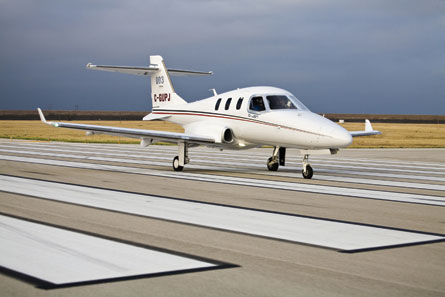For Peter Maurer, the new Canadian government's decision to turn down a vital loan request on 17 May does not spell the end of its D-Jet programme. But it does lengthen the odds on the single-engine personal jet ever reaching the market.
The president of Diamond Aircraft Canada spent weeks awaiting a decision by Ottawa on whether to lend the airframer $35 million. The cash would have been the last, necessary piece of a $90 million package that would have allowed Diamond to rehire 213 employees and complete certification of the D-Jet.
The Austrian-owned manufacturer was forced to suspend development of its flagship single-engined jet on 28 March and lay off more than half its workforce, despite being five years into a flight-test programme. Frustratingly for Maurer, Ontario-based Diamond had already secured most of the funds it needs - $20 million promised by founder Christian Dries and $35 million from the Ontario provincial administration. However, the latter was contingent on the same amount from the federal government.
The political impasse ahead of the election put the process in limbo, but Maurer had been confident the new Conservative administration, which has an enlarged majority, would see sense. For Maurer, the decision was not about bailing out a struggling business but providing a commercial loan that would have secured high-value aerospace jobs in Canada, Ontario and its home city of London.
 |
|---|
©Diamond AircraftDiamond's D-Jet remains grounded following the Canadian government decision |
"We are not asking for charity," said Maurer, who has run Diamond's Canadian offshoot since it was set up in the early 1990s, speaking before the government's latest decision. "This is a very good investment for the Canadian government, not just in jobs but in securing the future of all the technology development that we have started here. We have told them that the D-Jet is only the start. If we move forward, there is a lot more that we can do in the future." That, says Maurer, could include unmanned and special mission variants of its aircraft for the North American market.
Unlike other start-ups that come looking for public money, Diamond would have been a low-risk bet for Ottawa, he says. Along with its sister plant in Wiener Neustadt near Vienna, the London operation - which started life as a Second World War Mosquito factory - has grown along with Diamond's product portfolio, which began in the 1980s with the humble HK36 motorglider.
Learning to crawl
The company, which says its more-than-3,500 deliveries make it the third-largest general aviation manufacturer in the world, produces the two-seat DA20 and four-place DA40 piston singles in London, where it also performs final assembly of the DA42 Twin Star.
"We learned to crawl before we walked, and to walk before we ran. We are not some greenfield company," says Maurer, stressing that, even without the D-Jet programme, Diamond remains a big player in the GA sector.
Maurer is reluctant to give much detail about possible future programmes at London if the D-Jet is secured. However, Dries has alluded to larger and optionally piloted derivatives of the D-Jet, as well as unmanned versions of the DA42, a version of which has already been developed by Israeli company Aeronautics. With the training school market yet to recover from the downturn, special mission aircraft - based around the sensor-equipped DA42 MPP variant produced in Wiener Neustadt - have become the most lucrative part of the Austrian business.
If Diamond secures funding from elsewhere, Maurer reckons it will take 22 months to bring the D-Jet to certification - almost a decade since the model was announced in 2003. Three prototypes have been built, with the first aircraft taking to the air in 2006. Aircraft serial numbers two and three have flown 700h between them, but Diamond has suspended flight testing as well as engineering until the programme's future is known.
With a roomy two-plus-three cabin, the Williams FJ33-powered D-Jet tended to be bundled in with the likes of the Cessna Mustang, Eclipse 500 and Embraer Phenom 100 at the height of the very light jet craze in the mid-2000s. However, Diamond calls the single-engined aircraft a personal jet - or "flying limo". Most of the 225 orders are from owner-pilots, says Maurer. Diamond positions its jet as cheaper to operate than the twin-engined Mustang, yet more comfortable than the smaller-cabin Eclipse. The D-Jet's lower ceiling of 25,000ft (7,620m) is a small compromise, as most customers will be traditional piston aircraft aviators used to flying at that altitude, it says.
Walking around the shopfloor at London, there are spaces in which Diamond hoped by now to be producing its most ambitious programme. Maurer's hopes of quickly rehiring the laid off workers are fading fast. Bombardier is already thought to have sent scouts to the city and with every week that passes the chances of keeping them on standby, unpaid, recede. But he has not given up. With $20 million secured, Diamond will continue with "parallel efforts through other avenues" to secure the funding it needs. With Canada's new government unconvinced, it will be down to a saviour from elsewhere to fly to the rescue the D-Jet.
Source: Flight International



















